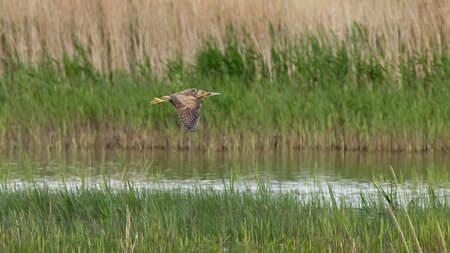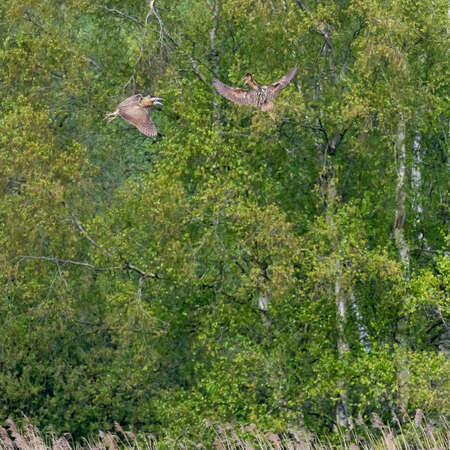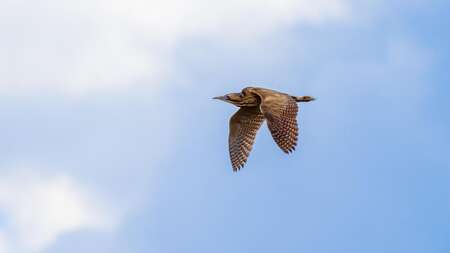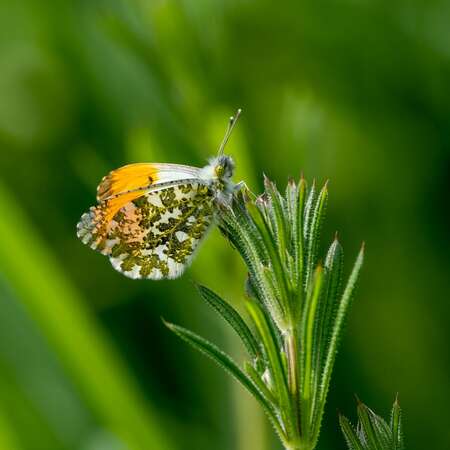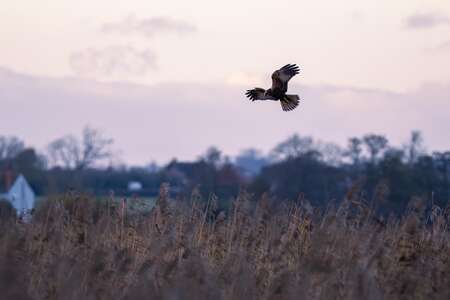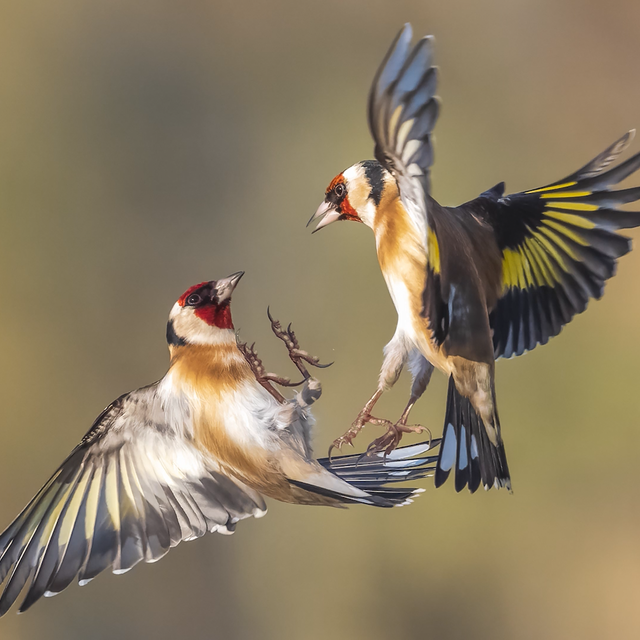It is early in the year and spring is in the air. We are in Somerset, looking for migrating birds. I am holding my new OM-1 camera with the 300mm f4 Pro lens and an MC14 extender when suddenly there is a commotion in the reeds. A bittern breaks cover, flying fast across the front of the reedbed. Despite the distance, Subject Detect picks up the bird with ease and tracks it, giving me a perfectly focused 11 frame sequence.
A tree briefly interrupts the view and then the track is on, until another commotion erupts. A second bittern flies up from the reeds, challenging the incoming male.
At this point, we are over 500 m away and the fighting birds are small dots in the viewfinder, yet the camera holds focus. The resulting picture will never win awards, but the behavior is fascinating.
Further along the path I see another bittern flying against a blue sky, offering a far more conventional picture.
Another favourite image from the day highlights the versatility of the 300mm f4 Pro lens. Once again equipped with the MC14 converter, I see an orange-tip butterfly resting on a plant beside a bridge. At under two metres away, the (effective) 840mm lens captures a beautiful close-up image.
So How is the OM-1 Working Out?
I was fortunate to get one of the first cameras in the UK, and I have never looked back. There are few cameras that can touch OM-1 when it comes to shooting wildlife. With bird detection and eye tracking, the camera ‘grabs’ focus and locks onto the bird, even against contrast backgrounds. This delivers frame after frame of perfectly focused pictures, even in light where it can be hard to see the bird, an example being the marsh harrier hunting as the sun set on the Somerset wetlands.
The OM-1 is not only a camera for wildlife photography though. The landscape below is a superbly detailed 50 Mpix image, captured hand-held with the High Res Shot mode.
The design of the OM-1 has clearly been thought through very carefully. Aside from regular photographic functionality, it is a computational photography master with many clever and useful tricks that belie its tiny size.
This is a marbled white butterfly, focus-stacked in camera, with (my favorite) 300mm Pro lens, to ensure the whole butterfly was in focus, wing tips and all.
The cutaway view shows the extraordinary detail that can be captured hand-held thanks to the unbeatable in-camera stabilization.
A favorite function, easily overused in landscape, is Live ND. It is designed to replicate the effect of using a high-factor neutral density filter to slow down motion. It takes a few seconds to activate the function from the menus and gives a beautiful effect for waterfalls and other fast-moving subjects.
Macro has long been one of Olympus’ key strengths, and the same now goes for OM SYSTEM cameras, thanks to their excellent and very well-priced macro lenses and the inbuilt focus stacking and bracketing. Below is a small trick picture in the studio, to show off the inbuilt focus bracketing. It shows a tiny common whelk placed atop a 5p piece. The image was focus bracketed with a sequence of images that were then stacked in third-party software.
Macro photography provides joy in the field. The Mycena vulgaris fungi were photographed using the diminutive but scalpel-sharp 60mm f2.8 macro lens. The image was close to a 1:1 macro, so a 10 frame in-camera focus stack was utilized to give the necessary depth of focus.
Still photography is crucial, but as more photographers realize the power of video, both for their work and social media, it has become increasingly important to be able to capture good quality film in cameras. This is where the OM-1 shines, with its capability to shoot 4k (3840x2160px) RAW videos at 60 fps and up to 240 fps at FHD (1920x1080px). More importantly, it can also shoot beautiful log clips, to allow for optimum grading in post-production, and the in-built stabilization and AF capabilities make this an extremely capable camera for projects of all levels.
The waterfall clip demonstrates the effect of filming moving water at 200 fps and slowing it down eight times.
To say that I am thrilled with the OM-1 is an understatement. This small but very mighty camera has replaced both a full frame mirrorless system and a video camera, equaling, and in many cases exceeding, the performance of both.
Bio - Nick Wilcox-Brown
ABOUT NICK WILCOX-BROWN
Website: wildphotographer.co.uk
Nick is a commercial, advertising, and wildlife photographer and film-maker, based near Bristol in South West England.
He has worked extensively with a wide range of well known brands including Land Rover, Aston Martin, Apple and magazines including Country Living, Hello, Country Living and The Tatler. His moving image projects have appeared on BBC, and National Geographic television.
Nick is privileged to have a close relationship with key camera and optics manufacturers. A software specialist and member of the Adobe Pre-release team, he presents Lightroom and Photoshop for Adobe at major events. This keeps him on his toes for regular teaching workshops and holidays featuring wildlife and landscape photography that he markets as 'The Wild Photographer'.
Nick has been approved by OM SYSTEM to run independent training workshops on the OM-1 camera and related products.
